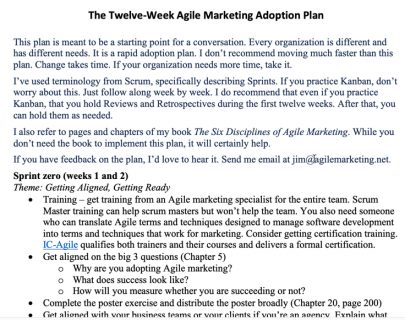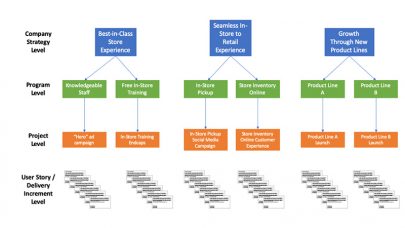LEARN MORE
TESTIMONIALS
“The world of business and marketing has changed forever. We identified Agile Marketing as one of our key strategies and Jim Ewel’s name kept coming up. Jim’s training on Agile Marketing for the agency was amazing. Jim got the key agency teams out of their comfort zones, and got them to start to think differently about not only how we interact with our clients, but also how we operate internally. The sessions were very hands on, practical and Jim left us with real, actionable next steps for the whole agency. Invaluable!”
– Jeff Plowman, V.P. Client Services, McMillan
“Great marketing teams know how to learn – and the best way to do that is through structured rapid experimentation. Through agile training, Jim provides the tools and process for teams to excel here and truly evolve marketing from an output to an outcome organization. Simply an incredible agile coach!”
– Caleb Rubin, VP of Marketing, Equitable Bank
“There is no ‘if’ every organization adopts Agile practices; there is only the question of ‘when.’ Jim’s approach is battle tested with his experiences over the past decade helping companies make the evolutionary leap to Agile. The moment you put his book down, you’ll be able to launch right into his time-tested approach to getting adoption with your teams.”
– Jascha Kaykas-Wolff, President, Lytics, Former CMO, Mozilla
“There are two kinds of marketers today—those that have embraced the shift to rapid iteration, and an outcome orientation (in a word: Agile), and those who are learning the hard way by being outplayed in the market. Jim Ewel has written a masterclass in Agile adoption, distilled from years of coaching growth organizations of all sizes through the transition.”
– Peter Francis, Head of Global Growth at Qualtrics
“Practical guidance and insight with immediate ‘ROI’ for marketing leaders in all stages of their Agile transformation journey.”
– Stephanie Ferguson, Corporate Vice President, Microsoft
WHY CHOOSE US
Jim Ewel began his Agile Marketing journey in 2010 and is one of the leading advocates for applying Agile to marketing. He was the co-organizer of the first gathering of Agile Marketers, called SprintZero, in June of 2012, and is one of the authors of the Agile Marketing Manifesto. He has helped companies as diverse as T-Mobile, Salesforce, Best Buy Canada, SpaceSaver, Great Dane Trailers, Northern Alberta Institute of Technology, and Zenprise learn about and adopt Agile Marketing.
DEEP MARKETING & BUSINESS EXPERIENCE
Jim has over 40 years of business experience in sales and marketing, in organizations of all sizes: from a 3-person startup to a 60,000 employee multi-national. He has served in multiple roles, including director of marketing, VP of marketing, CMO, and CEO.
DEEP AGILE EXPERIENCE
Jim’s first experience of Agile was in 2007 with a software development team. He has been applying agile to marketing since 2010. He has helped over 60 organizations adopt Agile, including Zenprise, Salesforce, Best Buy Canada, T-Mobile and many other mid-size and startup organizations.
EFFECTIVE COACH
Jim is not only an effective Agile marketing coach, but an effective business coach. His approach to coaching is not to tell you what to do, but to help you find solutions that are unique to you and your situation. He also has the experience of coaching over 60 organizations through the transition to Agile Marketing.
CERTIFIED
Jim was one of three subject matter experts who contributed to creating the Agile Marketing certification from IC-Agile. He was also one of the first trainers certified to offer certification classes. He has helped hundreds of students get their certification.
SUBSCRIBE
100% PRIVACY. A FEW EMAILS A MONTH. NO SPAM.











